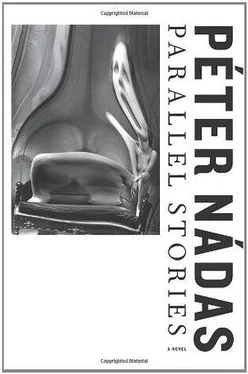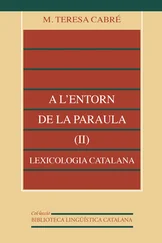They felt the spray of the fountain on their faces.
His origins do not restrain this man in the kind of tight familial and tribal net that obviously had not let her go or did not let her go far.
She could not take her eyes from the young man’s hair.
Not only was its color, a deep bronze red, unfamiliar, but also its texture, the thickness of the individual hairs, as well as his quickly fluttering eyelids, suggesting nervousness, and his dense eyebrows, attesting to constitutional tranquillity. The roots of his eyelashes were transparently blond, the arc of the lashes darkening gradually to bronze red. His rapid blinks gave the impression that eyelashes and eyelids were unconnected, each fluttering independently.
A little enviously, almost longingly, she thought to herself that this man was heavier than bronze yet would soar. A most original man. Freeing himself from the burdens of the material world. With no apparent mythic bonds.
Mrs. Szemző was curious about the relationship between personal experiences and the characteristics of larger surroundings beyond the personal; about the personal and historical pasts, about everything that was mythical and magical in the historical past, everything beyond individual life that recurred as ritual in deeds and words. Ultimately, she and her friends were concerned with similar issues and occupied with similar matters. Mária Szapáry dealt with the relationship of the body to the fabric draping it, between the body’s nakedness and its exposure, a subject profoundly and thoroughly, yet no less falsely, documented and developed in the history of civilization. They both asked the same question: what was unique in the material they were dealing with, what was general, what was collective and what was individual, how did one fit into the other and how could one be comprehended, shaped, and expressed through the other. Perhaps Margit Huber’s profession was the classic exception, for which the other women rather disliked her. A dompteuse d’animaux . Dobrovan’s basic question was also similar; originally she had wanted to rescue her mere body from this extremely old false world filled with superfluous gestures that restricted her senses.
After her terrible accident, her sight remained her only tool, helped by her hand, her drawing ability, and her attraction to handicrafts.
She designed and wove fabrics and worked for fashion designers.
She learned her profession from her Lithuanian boyfriend, who had studied with an ancient Parisienne, and both of them had probably paid for their skill with reluctant love. She was searching for possible practical solutions to the problem of how, on what levels and by what means, the unique personal imagination can be reconciled with the demand of the masses, and in what way handicraft can be linked to mass production. Or, in the reverse direction, what higher standards might the nature and methods of industrial production, and its new technical achievements, offer the public. Although none of her woman friends knew Madzar — he was much younger than they — they all spoke the same language of ascetic functionality, albeit in different dialects.
They instantly understood and liked what he did on Dobsinai Road and what he designed for Pozsonyi Road.
The given was the seventh-floor apartment in a building erected only a few years earlier and designed on principles of functionality and modular coordination like other similar buildings in the Újlipótváros district. On closer inspection, however, especially by a person who worked or lived in these buildings, one noticed that their interior proportions were determined neither by the necessarily modest scale of individual need nor by the era’s architectural aesthetic, dependent on collective Puritanism and personal asceticism, but by the profit motive of petty, insignificant designers and investors shamelessly exploiting an architectural style.
In truth, the business egoism of the larger context left its repressive stamp all over this quarter of Budapest.
Writhing under the enormous weight of its ongoing collapse, self-satisfied feudal Hungary drags itself from one economic crisis to another, lugging along the antiquated customs, traditions, and inexhaustible wounded pride of its failed aristocracy, which keeps an iron grip even on those who do not share their hope for prosperity in an illusionary greater Hungary or their confidence in the historical mission of the Hungarian people, but who feel great social responsibility for rural wretchedness and urban poverty, yet nevertheless adjust their professions’ rules and demands to the generally accepted and all-pervasive laws of the corrupt gentry.
If one decides to build on illusions, it is not easy to break free of hypocrisy and the worship of decoration.
It showed through in the floor plans; it showed through on the walls.
Mrs. Szemző instinctively understood what Madzar was talking about and what he abhorred.
The ceilings and windows were lower than they should have been though not by much. Not by much, and everything was less spacious and airy than what could be called desirable for a balanced, individual lifestyle. Once again entire streets had been laid out so the sun could not shine into the buildings. In the absence of appropriate architectural demands, transparent geometry turned into rigidity and constraint. Empty style. Material and fittings of questionable quality. Showy but inferior facings that could easily be detached from the underlying constructs. On his first visit to the empty apartment, Madzar already had the feeling that he was not standing on but hovering over the floor. Something wasn’t right with the construction. As if he were hearing an echo of barracks architecture from the First World War. Most buildings in Újlipótváros had an improvised look. They lacked the elementary joy that the personality and sensuality of true artisanship offers. As if every building component, in its symbolic language, were saying, well, it’s true, there is peace now, the lost war is behind us, but industry has not yet recovered, it has not been modernized, therefore we are producing inferior goods.
The ceilings and walls were flimsy. Even the more generously proportioned or better-built apartments were unpleasant to go into because the stairwells and entrances were too narrow, and though there were spaces where one could step out of the apartments, what was the point of so many congested balconies and loggia if they felt like dovecots.
The other side of the street was too near.
These buildings with their crippled interiors could not even present their facades to the outside world. They did not have enough room to look at themselves from any angle, and they couldn’t see how inconsiderate they were of one another.
They wanted to show something other than what they could show.
They had no air.
They either pretended to be open or tried to conceal being locked in.
After a few hours in the empty apartment, Alajos Madzar realized there was no partition wall, door, or window that he did not want to change. Mrs. Szemző had claimed that although historical givens should not be altered, sometimes a single creative professional move, a kind of trick of the trade, was enough, at least in theory, to alter the inner conditions of functionality and to influence the surroundings strongly.
Hearing this practical comment, Madzar asked himself whether there was such a trick in the architectural trade.
Of the many outmoded light fixtures, only one gave any light at night.
And now there was nothing in the spacious hallway except the open, pitch-black piano.
It stood heedlessly in place, just as the movers had heedlessly put it down more than a decade earlier.
In the wake of the wartime devastations, no one analyzed the traces of destruction anymore; neither did anyone look for some trick of the trade when a job was to be done, not anymore.
Читать дальше












